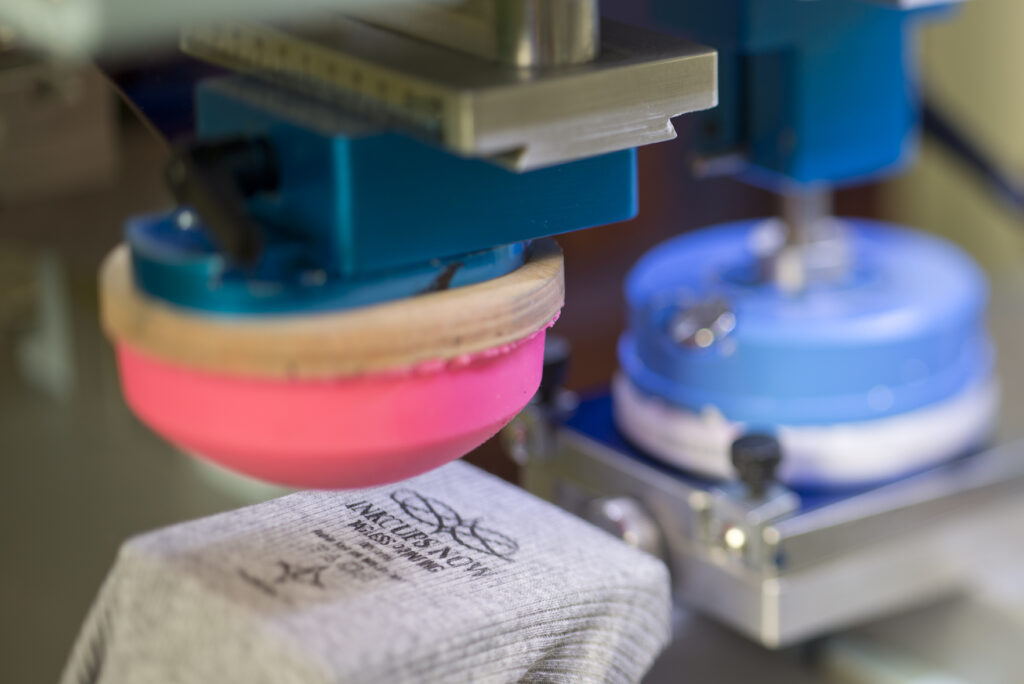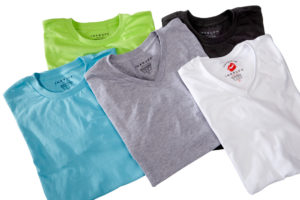- Equipment
- Inks & Supplies
- Services
- Applications
- Tagless
- Resources
- About Us
- Contact Us

Say goodbye to your typical tear-away tags, pad printing on apparel is here to stay! You may have seen popular t-shirt companies switch from a white sewn-in label to a print directly on your shirt. While many have sighed with instant relief, others have questioned the whereabouts of this tag that they intended to rip off anyway. The answer: companies have switched to tagless label printing.
There are numerous benefits of switching to pad printing on apparel; starting from the obvious increase in comfort for the consumer to ensuring your branding stays on the shirt and is not cut off or destroyed. Once you have decided to “go tagless” there are a few methods to choose from pad printing machines, heat transfer, and screen printing. For this post, we will discuss pad printing.

Pad printing is a process that has been used for centuries. Although technology has changed, the cycle has been the same. The pad picks up ink, the ink then sticks to the pad which is then pressed onto a substrate. The full process is outlined in our blog post titled Pad Printing: The Inkcups Way.
Although the pad printer itself is the largest piece of equipment, the smallest consumable: ink, is the most important. Each ink is unique in composition thus altering its adhesion to substrates. In any case, inks have come a long way in both resilience and color.
Clothing labels were originally used by Unionists to show activism against employers. After World War II, they became more of a Marketing tool to promote brands but also provide simple instructions on how to care for the clothing. Before the term ‘tagless’ there were 3 different ways to print tags: Woven – typically used for more expensive yet simple brands, screen printed – allows a bit more color to be used and inkjet – gives full-color labels with beautiful graphics. It wasn’t until a few years ago that ‘tagless’ made its appearance.
Pad printings inks are made out of a combination of 4 components: pigment, solvent, resins, and additives. The pigment refers to the color of the ink in powdered form, solvent is another term for thinner (not to be confused with the paint thinner you can purchase at a hardware store), resins form the ink and finally additives which aid in flexibility, flow, and pigment stability. To learn more about what ink is made out of and how to choose the correct ink, read Choosing the Correct Pad Printing Ink. Additionally, inks for apparel need to meet certain criteria as they will be in contact with skin. Certifications to look for include: California Proposition 65, Oeko-Tex Standard 100, CPSIA’08, NAMSA, etc.
Although pad printing is a great option for label-free apparel, pad printing light colors (white, pink, yellow, etc.) on dark fabrics proves to be a challenge for all. We’ll take the analogy of painting dark walls. If you have a wall that is painted navy blue but needs to be changed to white, it will take more than one coat of paint to fully block out the navy wall color. Painting only one coat will turn the white from opaque to slightly transparent. Once you start adding more coats, the navy will slowly disappear and the white will become the only color on the wall. This applies directly to pad printing light colors on dark fabrics. The first print will show to be grey (in the case of pad printing white).
To make the white more opaque, you will have to print multiple impressions. The problem is, it will take longer and the apparel could move, distorting the artwork and making it illegible.
[Update! We’ve improved this process with the all-new Brite Tagless Printer]
In addition, printing multi-colored tags is a struggle for pad printing. Companies that prefer simple 1 or 2 color labels will benefit from this process as the cycle time and overall cost of consumables will be low. Once the move is made from simple to a more intricate label (meaning more colorful) you’ll need to upgrade your 1 or 2 color pad printer to a 4 (possibly more) color pad printer. Although attainable, you will be sacrificing time and potentially quality.
In general, the pad printing process is the go-to for those who would like to print a simple, long-lasting label on garments. Pad printed labels can withstand at least 50 industrial washes and there is no way someone can remove your branding. Additionally, you will lower costs while getting your product out in a flash!
This infographic highlights the costs and benefits!
For more information about going tagless with Inkcups, please contact us.
Back to Blog Home
Add Your Comment